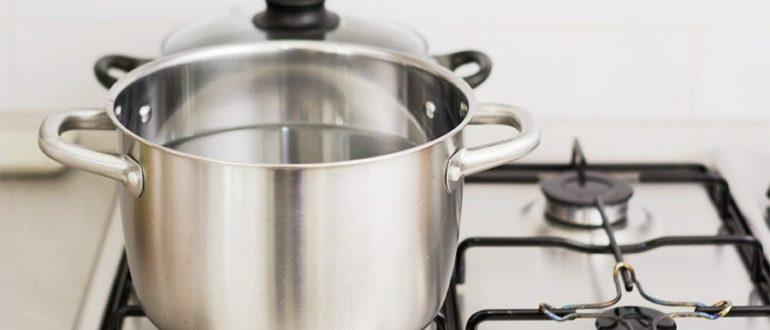The quality of the treat, as well as the ease of cooking, will depend more on which pot you prefer to use. While the dishes are on the counter in the store, they are really good, but in practice this property may not be justified.
One has only to start using the pan in the kitchen, as you may encounter burning, greasy marks and soot, which are very difficult to clean. Even a ladle that has served you faithfully for many years can leave solid scratches on the walls.
In fact, knowing how to choose the right pot can help you avoid a lot of trouble. When buying, pay attention to the design solution, but also devote time to the main properties of the dishes. If you do not understand what is at stake, then our article can be your excellent assistant. Let's get started!
Content
Which pot company to choose: a list of the best manufacturers
When deciding which pot to choose, many people go from one extreme to the other. Someone is looking for a cheaper option, but later they are faced with extreme disappointment at the expense of the quality of the dishes. There are those who prefer extremely expensive utensils from well-promoted brands, it may, and will serve for a long time, but the price will never pay off.
In the question of which pan is better to choose, we recommend staying on a solid version from those brands that have been able to recommend themselves in the market in the best way. They will be discussed below. It is worth admitting that even if the manufacturers have a positive reputation accumulated over the years, none of them raises the price of dishes above their heads.

We are talking about brands such as BergHoff, Rondell, Tefal, Konig, Fissler. It should be noted that many of the readers will agree that they know these names personally. There are other equally worthy brands that bring good kitchen attributes to the market. It is very difficult to list them all in one article, and therefore we decided to present only the most famous ones.
Pot selection: basic parameters
Volume
Volume is an important feature. Note that for the average family, 4 pots will be enough to prepare the main meals. When choosing them, be guided by the following parameters:
- For stews and goulash, 1-1.5 liters of a saucepan are suitable. If you live alone, then they will be enough for the first course;
- For a stew or soup for a family of 2-4 people, an option for 2.5-3 liters is suitable. But if it is not possible to cook the first one every day, then pay attention to the options of 3.5-4 liters;
- there are also 5L models, which are rarely used in everyday life. These are options for festive dishes, compotes. Those. those dishes that are timed to a large feast.
Wall and bottom thickness
This parameter is equally important. It will determine how long the dishes will serve you in the future. It is best to take 0.5-0.8 millimeters of sheet material. The smaller the thickness, the cheaper the cookware. But keep in mind that in the future it will disappoint with curved sides and dents that appear.
The assortment of leading manufacturers includes models of 1-2 millimeters. But for the price they are expensive. Please note that such options can last almost a lifetime.
As for the bottom, it should be thick. In this case, it will turn out to distribute the heat evenly, and the products will not be prone to burning. It is difficult to achieve this effect in products of a stamped sample, and therefore manufacturers prefer to equip such dishes with an encapsulated bottom with a multilayer look.
The best indicator would be 7-8 millimeters. This will allow the bottom to be heated well and quickly and will distribute the heat evenly.
Pens
The handles can be made in one piece if it is glass, ceramics or cast iron. Fastening is carried out by means of spot welding, bolts and rivets. In the first case, this is a reliable solution. And contact with the handle due to the small area does not give strong heating.
But the second mounting option looks better in appearance. But from the inside it is capable of being clogged with food particles. Rusting may also be noted.
Look at the handles when choosing a pot. It is important that they are long. In this case, it is more convenient to take on them. The heating will not be too strong. In another case, it is better to look for products with hollow handles, tubular type or overlays made of bakelite, wood, silicone with heat-resistant properties.
Price question: how much is a good saucepan
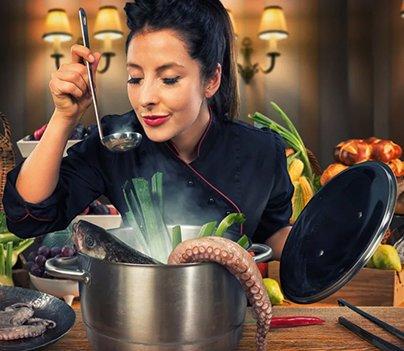
The prices on the market are different. If this is a stainless steel option, then the cost varies from 300 - 30,000 rubles. Enameled dishes cost around 200-8000 rubles, while cast iron costs 1-17000 rubles. Domestic companies also delight with budget options devoid of enamel - 700 - 3000 rubles.
As for ceramics, such dishes will cost 500-5000 rubles. The availability of glass pans on the market is not large, but you can find a good option. Prices range from 400-2000 rubles.
Varieties of modern pots
Cast iron pans
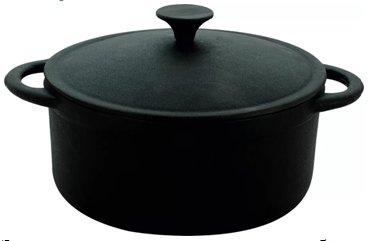
This is a cast cookware that is very heavy. It will last really long. If a fall occurs, it is not the dishes that will suffer, but the genital surface. Without protection, cast iron can face the rusting process, and therefore manufacturing companies cover the material with a non-stick or enamel layer.
But the most important thing is that the cast ware has a bottom with an enviable thickness, when the walls have high heat capacity properties. It is convenient to simmer and bake in such a saucepan, and the food will keep warm for a long time.
Benefits
- strength and durability;
- perfectly tolerate high temperatures;
- used for baking in the oven;
- keeps the temperature of the finished dish, suitable for storing food;
- abrasives are not terrible;
- excellent non-stick properties. But this does not apply to options that are enamelled.
disadvantages
- heavy weight;
- long heating;
- uncoated dishes must be greased with oil after washing, otherwise there is a possibility of rust.
Stainless pans
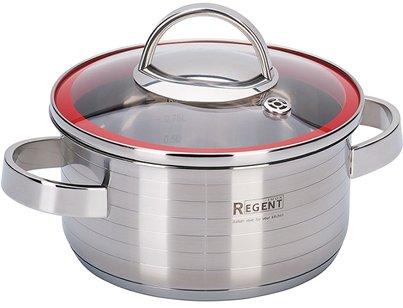
There is an increased demand for this product segment on the market. This is not surprising at all. It has many positive qualities. Initially, the indicators of hygiene should be noted. Such dishes look stylish, and if the hostess handles it correctly, then the pan will last for a decade.
When thinking about how to choose a stainless steel pot, pay attention to the bottom. It will be made in a thickened version. This is due to the fact that the company uses multilayer inserts based on aluminum or copper. If it were not for this, then the food burned badly during cooking. As a rule, it is very convenient to cook in such pans, and it pleases the fact that the modern assortment is presented in a wide variety. Everyone will be able to choose an interesting option for themselves, even if the choice falls on different series of products.
Benefits
- easy care. The material can be easily washed, no matter how dirty it is.He can withstand the use of a number of cleaning agents;
- the surface is scratch resistant;
- manufacturers delight with stylish design solutions, and therefore even kitchen attributes can be selected for the pan to create an interesting set for the delight of the hostess;
- heating is carried out very quickly;
- the bottom is made of many layers, and therefore the heat is distributed over it evenly, due to which the dish will not burn;
- high strength indicators. The only thing that can happen to the pan is damage from a fall. Those. a dent may appear;
- universality of application. You can cook both thick and liquid dishes in a saucepan.
disadvantages
- after a while, the stainless steel will fade and become stained;
- there are fakes on the market that are of low quality.
Enamel pots
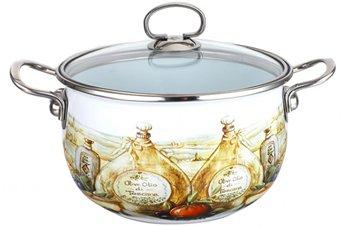
If you don't know how to choose a good saucepan, then pay attention to the enamel option. These are steel or cast iron models that will add coziness to every kitchen. Their strength indicators are also high. As a result, such dishes will be able to serve you for a long time due to the solid wall thickness. But please note that the coating is not impact resistant.
The enamel can chip. This will greatly ruin the appearance of the pan. It will strip the metal, which will subsequently rust, since there is no protection. In general, if a pothole appears from the outside, then the pan can be used in the future without problems.
Benefits
- a large assortment of colors is presented on the market, the variety of patterns that cover the enamel is also pleasing;
- the coating is hygienic. It is easy to clean. In such dishes, you can cook even those foods that have high acidity;
- the walls are not strong, they tend to deform;
- able to keep ready meals warm much longer than stainless steel dishes.
disadvantages
- the enamel coating should be protected from abrasives and impacts;
- if there is a chip inside, you should be away from the dishes altogether;
- not suitable for cooking thick and dairy dishes.
Ceramic pots
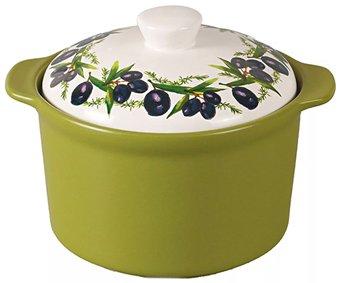
Such pans look very stylish and beautiful. Moreover, this is an environmentally friendly option. It will be appropriate for cooking food on the stove, as well as in the oven. Such dishes will perfectly withstand high temperatures, even if the differences are not shown to it. The latter fact is due to the fact that the pan has a chance to burst.
Such dishes are appreciated for the fact that they manage to keep heat for a long time. But the main plus is that each dish in it turns out to be incredibly tasty.
Benefits
- excellent scratch resistance;
- cleaning is simple;
- the bottom is thick, the walls distribute heat perfectly, due to which the products languish in their own juice;
- food does not tend to stick;
- can be used for microwave.
disadvantages
- shocks and falls are terrible for ceramics;
- the weight is large enough;
- cannot be used on induction cookers, but there is a way out - buy a combined type of pan equipped with a metal bottom.
Copper pots

These are really very beautiful pots, but the price for them is very high. The dish will be delicious and will last for a long time. This is due to the fact that copper has special antibacterial properties. But keep in mind that it not only kills pathogens in foods, but also destroys vitamins in them.
There is an unpleasant feature in such dishes. You will need to constantly polish the saucepan until it shines. If you can apply a protective coating, then an oxidation process will start, which can be resisted, but very difficult.
Benefits
- beautiful appearance;
- heats up quickly;
- food almost never burns;
- modern options have a protective coating inside, which will prevent copper from coming into contact with products.
disadvantages
- high price, difficulty in leaving;
- not suitable for cooking sour dishes;
- do not wipe the dishes dry, then patina spots may appear.
Glass pans
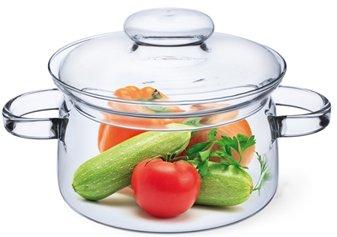
A similar option is made on the basis of refractory glass.This is a hygienic and safe for health option, in which nothing will burn. The material is characterized by heat-resistant properties. Due to this, cooking in the oven or on the gas stove is available. Such dishes can even be washed with a metal scraper. None of the funds will harm her.
Not every housewife has such a saucepan in the arsenal. This is due to the fact that many are afraid of the fragility of glass. But keep in mind that if you handle the dishes with care, they will last you a year, and even will delight you in appearance.
Benefits
- ease of cleaning, even if complex contamination is observed;
- lack of odors from products, the surface is not stained with juices;
- used for oven and microwave;
- food does not burn;
- environmental friendliness.
disadvantages
- temperature drops are contraindicated;
- for cooking on gas, you need to purchase a divider;
- in case of impact, there may be a split;
- not suitable for induction cookers.
Aluminum pans

This type of pots can be stamped on the basis of thin sheet aluminum or cast. In the first case, buyers will be pleased with the pricing policy. Plus, this is a lightweight option, but keep in mind that it is easily deformed, and therefore the market demand for this species is not high.
The second option is similar in properties to the use of cast iron dishes. But unlike cast iron, such a pan heats up very quickly and does not tend to rust.
Benefits
- fast cleaning;
- fast heating and cooling;
- can be used for cooking on an open fire, electric burners, except for induction cookers;
- inexpensive price.
disadvantages
- food burns, even if it is molded dishes with thick walls;
- if there is no protective coating on aluminum, it will quickly oxidize, darken, become covered with efflorescence and stains;
- not suitable for cooking acidic foods, for example, compote, borscht, and it is also not recommended to store food in such a pan after cooking.
Basic recommendations for choosing a pan from a specialist
- which of the pots you choose, give preference to those options that have a thicker bottom and walls. Also see that the non-stick coating is presented in a larger layer, of course, if provided;
- good pots with handles that are screwed on;
- make sure that there are no defects on the dishes;
- check how well the lid holds, it should not fall if you tilt the pan;
- the bottom must be stable and even;
- no need to buy kits. It is better to make your kit by choosing pots from different materials. For example, a cast iron cauldron is best suited for cooking meat and pilaf, but ceramic dishes are best for stewing vegetables. For cooking, it is recommended to use the enamel version, but for the diet - Teflon models. Of course, there is a universal option - this is a stainless steel pan. It must be exactly in the collection of every housewife;
- for microwave ovens, choose cookware based on thick glass or ceramics. A volume of 1.5-2 liters is sufficient;
- for sauce and dairy dishes you will not find better than a copper saucepan. But keep in mind that it has an additional layer of stainless steel inside. It is also important that the handles are long and tubular;
- if you have an induction cooker, choose a pot more carefully. Make sure that the utensil is equipped with a thick encapsulated bottom. It can be either slightly concave or even. Make sure its magnetic properties are present. To do this, you need to bring the magnet to the bottom cavity, always from the outside. It should stick instantly.

